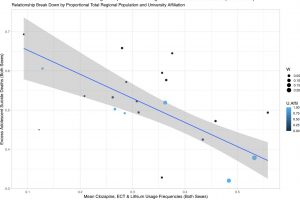Regional ECT, lithium, and clozapine use linked to lower suicide rates in male adolescents

![Mean Treatment Usage Frequencies and Regional Excess Suicide Deaths across 2016–2020 [Both sexes]. The Y-axis depicts the regional mean of min-max normalized year-wise differences in suicide deaths per 100,000 inhabitants between adolescence and young adulthood. The X-axis depicts regional mean values of min-max normalized clozapine, ECT and lithium treatment usage frequencies across 2016–2020 values. The slope and confidence intervals (CI:s) of the robust linear regression model contrasting these two variables are depicted as a blue line (slope) with gray shading (CI:s). Region population in relation to the national population is illustrated by the circle diameter, and counties affiliated with medical universities are highlighted in blue. These include Skåne region with Lund University, Stockholm region with Karolinska Institutet, Uppsala region with Uppsala University, Västerbotten region with Umeå University, Västra Götaland region with Gothenburg University/Sahlgrenska Academy, and Östergötland region with Linköping University. The figure demonstrates that regional mean of min-max normalized clozapine, ECT and lithium usage frequencies across 2016–2020 are inversely correlated with regional excess adolescent suicide deaths in the combined sexes group (β = –0.613, p-value = 0.0003, multiple R-squared: 0.123, adjusted R-squared: 0.077, 95% CI: –0.338, –0.889). Abbreviations: 95% CI, 95% confidence interval; ECT, electroconvulsive therapy; U.Affil, medical university affiliation (regions affiliated to medical universities are colored in blue and regions unaffiliated to medical universities are colored in black); W, weights (regional population size expressed as a percentage of the total national population). Credit: Nature Communications (2023). DOI: 10.1038/s41467-023-36973-4 Regional ECT, lithium, and clozapine use linked to lower suicide rates in male adolescents](https://scx1.b-cdn.net/csz/news/800a/2023/regional-ect-lithium-a.jpg)
A new study from Karolinska Institutet suggests that electroconvulsive therapy (ECT), lithium, and clozapine may reduce suicide rates in adolescent men with severe mental illness, consistent with previous findings in adults. The study, published in Nature Communications, compared treatment and suicide rates across different regions in Sweden.
Annually, there are 800,000 suicide deaths worldwide. Suicide is the leading cause of death among teenagers and young adults, with up to 90% of those affected having a serious psychiatric illness such as depression, bipolar disorder, or schizophrenia.
ECT and the drugs clozapine and lithium are evidence-based treatments for these conditions. While previous studies have shown that these treatments reduce the risk of suicide in adults, it is unclear if they have the same protective effect in young people. Researchers at Karolinska Institutet have now tried to find an answer.
“We studied if regional suicide rates in 15- to 19-year-olds were linked to the use of ECT, lithium, and clozapine in young people,” says Dr. Adrian E. Desai Boström, the study’s lead author and a postdoc researcher at the Department of Clinical Neuroscience, Karolinska Institutet.
The researchers analyzed registry data from 21 Swedish regions between 2016 and 2020. During this period, 632 individuals aged 15 to 24 committed suicide, of which 200 were between 15 and 19 years old.
The excess death rate was measured by comparing suicide levels among 15- to 19-year-olds and 20- to 24-year-olds in the same region. Regions with a comparatively lower suicide rate among 15- to 19-year-olds than 20- to 24-year-olds had higher usage of ECT, lithium, and clozapine in treating young patients.
As the study was observational, it cannot establish causal relationships. However, the findings align with previous research on adults, suggesting that ECT, lithium, and clozapine may also reduce suicide risk in adolescents.
“The results signal that early intervention with medico-psychiatric treatment for severe mental illness can reduce suicide rates in late-teenage boys,” he says.
The study also highlights substantial regional variations in the use of ECT, lithium, and clozapine in adolescent psychiatric care.
“Our findings indicate unequal access to best-practice care for seriously ill young patients in Swedish child and adolescent psychiatry. Improved care holds the potential for lowering suicide death rates among young men in Sweden,” says Dr. Desai Boström.
“The next step for the research group is to evaluate whether these treatments can also be protective for other severe psychiatric diseases with high mortality rates and a relative lack of effective treatment. For example, they hope to investigate whether ECT could be used for severely affected eating disorder patients with comorbid depression.”
Dr. Desai Boström suggests that such studies could not only evaluate the impact of treatments on suicide risk but also on positive therapeutic outcomes like enhanced functional capacity, cognitive function, and long-term quality of life.
More information:
Regional Clozapine, ECT and Lithium Usage Inversely Associated with 4 Excess Suicide Rates in Male Adolescents, Nature Communications (2023). DOI: 10.1038/s41467-023-36973-4
Journal information:
Nature Communications
Source: Read Full Article




